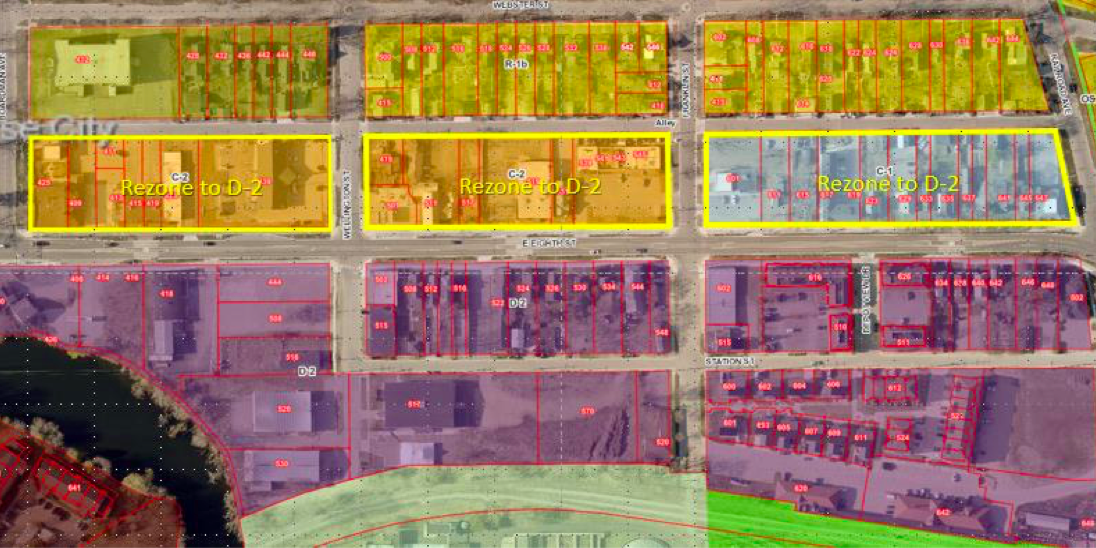
Traverse City planning commissioners will hold a public hearing Tuesday on several proposed zoning changes to Eighth Street, which could open up the types of businesses allowed on several blocks and change parking, building height, operating hours, and other rules for the corridor.
Planning commissioners will consider rezoning the 400, 500, and 600 blocks of Eighth Street’s north side – the stretch located between Boardman and Railroad avenues – from C-1 Office Service/C-2 Neighborhood Center to D-2 Development District (pictured, map). The change would make the main Eighth Street commercial corridor largely one consistent zoning district. According to City Planning Director Russ Soyring, while the “development intensity allowed by the rezoning is essentially the same as the current zoning of these properties,” the new D-2 designation would allow for several new types of business uses on the blocks. That would prove particularly true if planning commissioners approve a series of changes for Development Districts as a whole, also on the meeting agenda for Tuesday.
Some of the uses for the rezoned properties on Eighth Street would be allowed by right and include artisan manufacturing facilities up to 8,000 square feet – such as jewelry and clothing production facilities – along with parking decks and banquet halls/conference rooms with a maximum capacity of 500. Conference centers and retail uses over 8,000 square feet would be allowed with a special use permit.
Building heights would be limited to 45 feet on the north side of Eighth Street and 60 feet on the south side of Eighth Street, with some flexibility in height offered within those limits to developers if at least 25 percent of the building includes residential units. The tweaked rules would limit hours of operation for outside service and entertainment to 10pm, a cutoff that would also apply to indoor operation on the north side of Eighth Street’s 600 block between Franklin and Railroad.
The revamped ordinance also tweaks lodging and setback rules for Development Districts in an attempt to balance business and residential uses, particularly in the Eighth Street corridor. Lodging facilities would not be allowed on the north side of Eighth Street in the 400, 500, and 600 blocks, but could occur elsewhere in D-2 if limited to 20 units or suites.
Vacation rentals in the rezoned Eighth Street corridor would need a city vacation rental license, be located on a parcel with at least two units, and use either one unit or no more than 25 percent of total units – whichever is greater, depending on the building size – for short-term rentals. Those conditions match new rules passed by city commissioners this summer for vacation rentals in C-1 and C-2 districts.
In an acknowledgement of the close proximity of Boardman Neighborhood to businesses on Eighth Street, the tweaked rules require commercial buildings in the rezoned D-2 corridor to have at least a 20-foot setback if they’re on an alley across from a residential neighborhood. Any part of those buildings that’s within 30 feet of the alley right-of-way can only be 35 feet high at a maximum, to avoid dwarfing neighboring homes and becoming overly imposing on residences. The rules would be applicable to new building developments in the district.
During a November review of the proposed changes, some planning commissioners also expressed interest in revisiting parking rules for businesses – notably minimum and maximum parking space requirements. Based on their input, the board Tuesday will consider changing the parking maximum cap for commercial uses from 1 parking space per 150 square feet to 1 space every 250 square feet. The formula for parking minimums would also change, essentially reducing the number of required parking spaces at restaurants or commercial businesses by six spaces.
“For illustration, under the current rules, a retail use with 3,500 square feet of gross floor area is currently required to have 10 parking spaces. If the parking deduction suggested above is enacted, that business would only need to provide 4 parking spaces,” wrote Soyring in a memo to planning commissioners. “This equates to a reduction of 60 percent in parking space requirements. Under current rules, a 35,000 square foot retail store would be required to have 100 parking spaces, but only 94 spaces if the parking deduction is enacted. This would provide a 6 percent reduction in parking space requirements. As you can see, the suggested change will have a significant impact for small businesses, but little impact for larger developments. Staff feels this incremental change of reducing the number of mandated parking requirements will help small business start-ups.”
Planning commissioners have been discussing possible zoning changes to Eighth Street since at least 2018, when the board tried to create a new form-based code for the corridor – or an overhauled zoning plan for the entire district. The board eventually abandoned that approach, finding that many aspects of the existing zoning code were working well as written. However, planning commissioners have continued to look at individual tweaks to zoning rules that would help make Eighth Street more cohesive as a district and regulations more consistent for developers from block to block. Any changes approved Tuesday by the planning commission would next go to city commissioners for final adoption.
"street" - Google News
December 31, 2020 at 12:01PM
https://ift.tt/3rH8Qot
Zoning Changes Proposed For Eighth Street - Traverse City Ticker
"street" - Google News
https://ift.tt/2Ql4mmJ
Shoes Man Tutorial
Pos News Update
Meme Update
Korean Entertainment News
Japan News Update


No comments:
Post a Comment